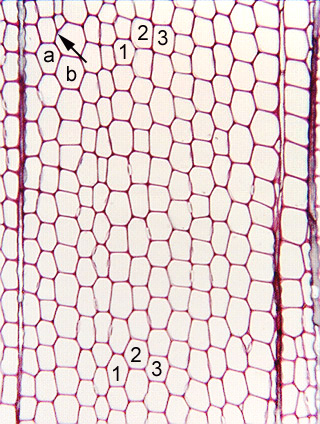 Fig.
15.2-11. Transverse section of pine wood. In conifers, all cells
derived from the fusiform initials of the vascular cambium develop into
tracheids, and all tracheids have more or less the same size. Consequently, the
tracheids form extremely regular patterns of uniform radial rows of cells, every
tracheid in a radial row being the daughter cell of the same fusiform initial.
Consequently, the
pattern of tracheids is a record of the activity of the fusiform initials.
Notice that radial rows 1, 2 and 3 are regular, each being a single file of
tracheids. But look at the arrow’s tip: at that point, a new row has appeared.
When the vascular cambium was at that location, a fusiform initial divided such
that it produced a second fusiform initial (this is called a multiplicative
division). With the extra cell in the vascular cambium, the cambium
could then begin making an extra row of tracheids. The fusiform initial that
produced the extra initial might have been the one producing row a or it could
have been the one producing row b. See pages 304 to 308 in Plant Anatomy by
Mauseth, and especially see Fig. 14.10 on page 307 for a diagram of excellent
research on this by M. W. Bannan.
Fig.
15.2-11. Transverse section of pine wood. In conifers, all cells
derived from the fusiform initials of the vascular cambium develop into
tracheids, and all tracheids have more or less the same size. Consequently, the
tracheids form extremely regular patterns of uniform radial rows of cells, every
tracheid in a radial row being the daughter cell of the same fusiform initial.
Consequently, the
pattern of tracheids is a record of the activity of the fusiform initials.
Notice that radial rows 1, 2 and 3 are regular, each being a single file of
tracheids. But look at the arrow’s tip: at that point, a new row has appeared.
When the vascular cambium was at that location, a fusiform initial divided such
that it produced a second fusiform initial (this is called a multiplicative
division). With the extra cell in the vascular cambium, the cambium
could then begin making an extra row of tracheids. The fusiform initial that
produced the extra initial might have been the one producing row a or it could
have been the one producing row b. See pages 304 to 308 in Plant Anatomy by
Mauseth, and especially see Fig. 14.10 on page 307 for a diagram of excellent
research on this by M. W. Bannan.